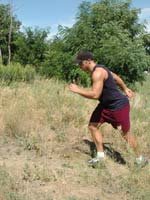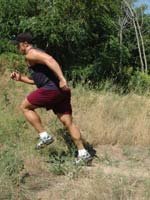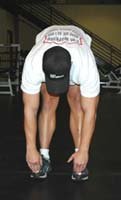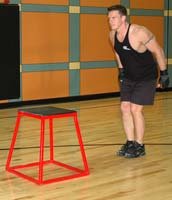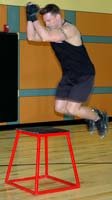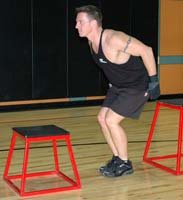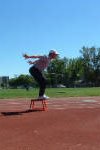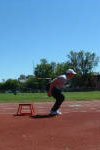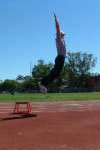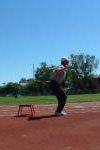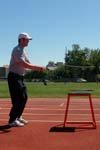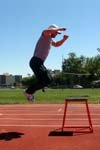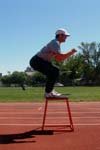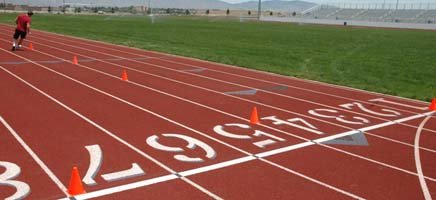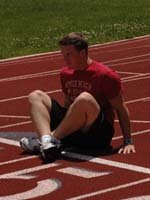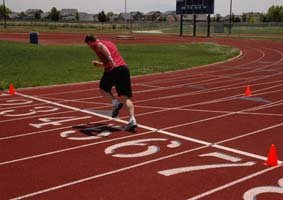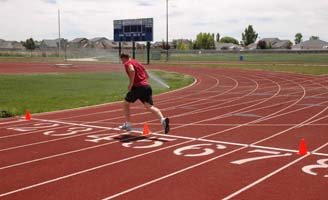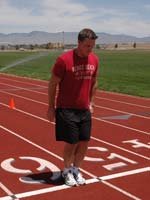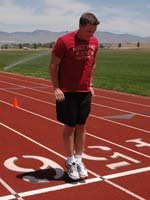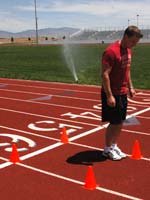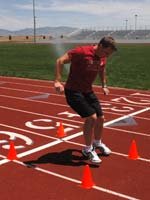The Question:
Speed and agility are very important qualities of a good athlete. Some sports can rely solely on speed and agility.
How can you increase your speed and agility? Be specific?
Which sports require a lot of speed and agility?
Which sports require little speed and agility?
Do you train for speed and agility? If so, how often? If no, then why not?
Show off your knowledge to the world!
The Winners:
1. ravadongon View Profile
2. Blink41 View Profile
3. Joe Mil View Profile
3. TUnit View Profile
New Prizes:
1st place - $75 in store credit.
2nd place - $50 in store credit.
1st Place - ravadongon
View This Author's BodySpace Here.
Speed and agility is an important part of many common sports and developing these two attributes can make a massive difference to your performance. Below I will guide you through the basics to start improving your speed and agility and help you get on track to becoming a more powerful and explosive athlete.
Increasing Speed & Agility
How Can You Increase Your Speed And Agility? Be Specific?
There are many ways you can increase your speed depending on many attributes such as your level of fitness, training experience, body composition etc.
For the average trained athlete the quickest way to increase linear speed is through short sprints with full recovery (5-50m for team sport athletes) and improving technique. Weight training (via improving relative body strength i.e. strength/bodyweight) will help improve speed. Without sprinting it will not have much of an impact on increasing your speed. The same goes for leaping and bounding plyometric drills and improving flexibility and mobility.
Improving technique requires a coach to analyze, critique and suggest improvements whether that coach is physically present at your training sessions or not (i.e. posting videos of your training sessions online to your coach is an option).
For the untrained athlete the quickest way to increase linear speed (as well as agility) is through improvements in body composition (i.e. losing fat if overweight or increasing muscle mass if underweight) and GPP (stands for general physical preparation i.e. in the case of sprinting boosting general fitness and relative body strength).
Max effort sprinting and agility training is not required until the untrained athlete has reached a suitable body composition and level of GPP.
Agility refers to the ability to start, stop and change direction. Most training drills that develop agility can be very stressful on the joints and on soft tissue and hence must be done with low volume. Examples of these higher impact drills are plyometric drills (leaping and bounding) and cone drills. Medicine ball drills fall under the low impact category.
In the in-season it is not necessary to work on high impact agility drills. Practices and games will cover specific agility required for the sport. Doing more agility drills will not provide any extra benefit during this time. It will only increase the chance of injury.
There's a lot of misinformation out there about sprint training, so be careful what you read. In the opinion of most good sprint coaches, getting fast requires you to train smart rather than train hard.
You shouldn't feel absolutely dead on your feet with bucket loads of lactic acid flooding your muscles after any session (this will only hamper recovery between sessions, which is not ideal; recovery is the key to progress). Whenever you feel you start to slow from fatigue, the session should stop immediately. It's important to remember you are not training to be a slow, long distance runner, you're training to be a powerful, explosive athlete.
Before I get into the sample routines, I must mention that training to get fast and agile can be hard on the body (even moreso if the volume is higher). Not only do your muscles need time to recover but so does your CNS (Central Nervous System), which controls motor responses to sensory stimulus in the body.
It is recommended you have at least 48 hours rest between high intensity training days in order to optimize the functioning of the CNS so you can train at your best every high intensity session, so between each high intensity day you can have a low intensity day to recuperate.
Below is a sample training schedule to improve speed and agility in the off season geared toward team sports athletes (that's not to say it wouldn't benefit other types of athletes, but their training may take a different focus, particularly track and field athletes).
Pre/in-season training would require the athlete to be able to adjust his training volume to fit the frequency and intensity of the team practice sessions/games i.e. if the athlete is going through a high intensity team practice/game regimen then the training volume and frequency for weights and sprint training would need to be lowered and agility training removed (If you don't understand you'll see better when I discuss my own training plans).
Disclaimer: As with undertaking any exercise program be sure to consult a physician before jumping straight into any of the program or exercises listed below.
Off Season (Trained Athlete)
Day 1 (HI): Sprints & Weights:
(AM) Sprint Training:
- General Warm-up (i.e. bodyweight circuit - squats, push-ups, chin-ups, jumping jacks etc, aim is to raise body temperature)
- Dynamic stretching (i.e.20m repetitions of high knee lifts, bum kicks, walking lunges, carioca etc.)
- Mobility work (i.e.8-10 reps of lying scorpions, lying cobras, bridges, fire hydrants, bird dogs, mountain climbers, groiners, hurdle mobility work etc.)
- Sprints (1-2x10m, 1-2x20m, 1-2x30m, 1-2x40m, 1-2x50m - full recovery 1min/10m minimum, various starting positions i.e. 3 point stance, lying down, mountain climber start, facing back, jump back)
- Flying Sprints (30m build up then max effort for 1x20m, 1x25m, 1x30m - full recovery as per above)
(PM) Weights:
- General Warm-up
- Dynamic Stretching/Mobility work
- Squats/Deadlifts (or variation) - 3 x 3-6
- Pull-up/Row (or variation) - 3 x 5-10
- Unilateral Leg Ex (i.e. lunge or variation, split squats) - 3 x 6-12
- Bench Press/Shoulder Press (or variation) - 3 x 8-12
Click Here For A Printable Log Of Day 1.
Day 2 (LO): Recovery/GPP Conditioning Day:
(I recommend tempo runs for recovery/conditioning work, as it is the best form of general fitness/aerobic work for an athlete. It doesn't interfere with sprint training, boosts recovery and enhances capiliarization (see links at bottom of article for more information on benefits and such). In addition sled dragging, med ball throws, strongman circuits, bodyweight callisthenic circuits, hill sprints etc. are also good and fun options ... just don't do something that is high intensity i.e. near max effort).
(AM) Tempo Runs:
(60-75% effort runs for 50-400m repetitions with 1/2 the rep distance walking recovery between reps, for between sets recovery walk double the rep distance, keep total volume < 3000m, when you can no longer maintain the pace you started at stop the session; to increase difficulty either increase volume or decrease recovery)
NOTE: generally 50-100m reps should be used for athletes in team sports.
(PM) Recovery Work:
I.e. massage, foam roller, contrast showers, Epsom salt bath etc.
Day 3 (HI): Agility & Weights:
(AM) Agility Training:
- General Warm-up (i.e. bodyweight circuit - squats, push-ups, chin-ups, jumping jacks etc.)
- Dynamic stretching (i.e. 20m repetitions of high knee lifts, bum kicks, walking lunges, carioca etc.)
- Mobility work (i.e. lying scorpions, bridges, fire hydrants, bird dogs, mountain climbers, groiners etc.)
- Explosive Med-ball throws (forward overhead and backward overhead, 2 sets of 10 each, 3 minutes recovery)
- Plyometric drills (2 exercises, 1 set of 10 each, full recovery)
- Cone drills (2 exercises, 2 sets each)
- High intensity sports specific drills (2-3 drills, 2-3 sets each)
- Cool down/recovery
(PM) Weights:
- General Warm-up
- Dynamic Stretching/Mobility work
- Squats/Deadlifts (or variation) - 3 x 5-10
- Bench Press/Shoulder Press (or variation) - 3 x 3-6
- Pull-up/Row (or variation) - 3 x 8-12
- Weighted Abs/Ab Circuit - 3 x 10-20 OR 2-3 circuits of mixed ab exercises
- Cool Down/Recovery
Click Here For A Printable Log Of Day 3.
Day 4 (LO): Recovery/GPP Conditioning Day:
(AM) Tempo Runs Or Other Form Of Conditioning
(PM) Recovery Work
I.e. massage, foam roller, contrast showers, Epsom salt bath etc.
Day 5 (HI): Sprints & Weights:
(AM)
- General Warm-up (i.e. bodyweight circuit - squats, push-ups, chin-ups, jumping jacks etc.)
- Dynamic stretching (i.e. 20m repetitions of high knee lifts, bum kicks, walking lunges, carioca etc.)
- Mobility work (i.e. lying scorpions, bridges, fire hydrants, bird dogs, mountain climbers, groiners etc.)
- Sprints (3 x 45m, 2 x 30m, 1 x 15m - full recovery 1min/10m minimum, various starting positions i.e. 3 point stance, lying down, mountain climber start, facing back, jump back)
- Flying Sprints (30m build up then max effort for 1x35m, 1x20m, 1x15m - full recovery as per above)
- Cool down/Recovery
(PM) Weights
- General Warm-up
- Dynamic Stretching/Mobility work
- Squats/Deadlifts (or variation) - 3 x 8-12
- Pull-up/Row (or variation) - 3 x 3-6
- Hip extension Ex (i.e. Good Mornings, Hyperextensions, Romanian/Stiff Legged Deadlifts) - 3 x 6-12
- Bench Press/Shoulder Press (or variation) - 3 x 5-10
- Cool down/Recovery
Click Here For A Printable Log Of Day 5.
Day 6: Rest/Recovery/Low Intensity Sports Specific Drills:
Day 7: Rest/Recovery:
Off Season (Untrained Athlete)
Day 1 (HI): Explosive Medicine Ball Throws, Plyometrics & Weights:
(AM) Explosive Med Ball Throws + Plyos
- Explosive Med ball throws (2-3 x 5-10 reps - forward OH, backward OH, (forward OH), sprint to ball between reps, rest 3-6 mins between sets) Rest 5-10 minutes between
- Plyometrics (2-3 exercises, 1-2 sets of 8-10 each, rest 2-3 minutes between exercises, see link at bottom of article for exercise selection)
(PM) Weights
- General Warm-up
- Dynamic Stretching/Mobility work
- Squats/Deadlifts (or variation) - 2 x 5-10
- Pull-up/Row (or variation) - 2 x 5-10
- Unilateral Leg Ex (i.e. lunge or variation, split squats) - 2 x 8-12
- Bench Press/Shoulder Press (or variation) - 2 x 5-10
Click Here For A Printable Log Of Day 1.
Day 2: Tempo Runs & Recovery:
(AM) Tempo Runs
(60-75% effort runs for 50-400m repetitions with 1/2 the rep distance walking recovery between reps, for between sets recovery walk double the rep distance, keep total volume <3000m, when you can no longer maintain the pace you started at stop the session; to increase difficulty either increase volume or decrease recovery) NOTE: generally 50-100m reps should be used for athletes in team sports
(PM) Extra Recovery Work
(I.e. massage, foam roller work, Epsom salt bath, contrast showers etc.) OPTIONAL
Day 3: Explosive Medicine Ball Throws, Hill Sprints & Weights:
(AM) Hill Sprints & Plyometrics
- General Warm-up
- Dynamic Stretching/Mobility work
- Hill Sprints (2-3 x 5-10 reps, rest 3-5 mins between sets) 5-10 minute rest between
- Explosive Med ball throws (2-3 x 5-10 reps - backwards OH, forward OH, (backward OH), sprint to ball between reps, rest 3-6 mins between sets)
(PM) Weights
- General Warm-up
- Dynamic Stretching/Mobility work
- Squats/Deadlifts (or variation) - 2 x 5-10
- Bench Press/Shoulder Press (or variation) - 2 x 5-10
- Pull-up/Row (or variation) - 2 x 5-10
- Weighted Abs/Ab Circuit - 3 x 10-20 OR 2-3 circuits of mixed ab exercises
Click Here For A Printable Log Of Day 3.
Day 4: Tempo Runs & Recovery:
(AM) Tempo Runs
(PM) Extra Recovery Work
(I.e. massage, foam roller work, Epsom salt bath, contrast showers etc.) OPTIONAL
Day 5: Hill Sprints, Plyometrics & Weights:
(AM) Hill Sprints + Plyos
- General Warm-up
- Dynamic Stretching/Mobility work
- Hill Sprints (5-15 degree gradient approx, 2-3 x 5-10 reps, rest 3-5 mins between sets) Rest 5-10 minutes between
- Plyometrics (2-3 exercises, 1-2 sets of 8-10 each, rest 2-3 minutes between sets and exercises, see link at bottom of article for exercise selection)
(PM) Weights
- General Warm-up
- Dynamic Stretching/Mobility work
- Squats/Deadlifts (or variation) - 2 x 5-10
- Pull-up/Row (or variation) - 2 x 5-10
- Hip Extension Ex. - 2 x 8-12
- Bench Press/Shoulder Press (or variation) - 2 x 5-10
Click Here For A Printable Log Of Day 5.
Day 6: Tempo Runs/REST & Recovery:
(AM) Tempo Runs OR REST
(PM) Extra Recovery Work
(i.e. massage, foam roller work, Epsom salt bath, contrast showers etc.) OPTIONAL
Day 7: Rest
Speed & Agility Sports
Which Sports Require A Lot Of Speed & Agility?
Athletic events require you to have speed, and not just the 100 meter dash, 200m and 400m and hurdles, but also triple jump and long jump. Almost all team sports require you to be fast and agile, these include sports like football, basketball, rugby, baseball and hockey. Racquet sports like tennis, squash and badminton also require you to be fast and agile, however generally over much shorter distances than team sports.
Non Speed & Agility Sports
Which Sports Require Little Speed & Agility?
Endurance sports such as long distance running, cycling, swimming and rowing don't require much speed or agility, neither do many target sports (e.g. archery, bowling and golf) or table sports (e.g. pool, snooker and board games).
Training For Speed & Agility
Do You Train For Speed & Agility? If So, How Often? If No, Then Why Not?
I do train for speed and agility since I play football (Australian Rules) and speed and agility are an important component of the sport. In the off-season I will generally have 2 speed, 1 agility and 3-4 weight training sessions per week, while in the in-season I limit it to 1-2 speed (low volume) and 2 weight training (low volume) sessions per week. I have two team practice sessions per week and one game.
My Speed Sessions Involve:
- General warm-up and mobility work
- Sprint build ups (short distances at 50-80%)
- Max effort sprinting (5-40m per set, 1 minute recovery per 10m, 200-350m total volume)
- Cool down and static stretching
My Agility Sessions Involve:
- General warm-up and mobility work
- Med-ball throws (forward overhead and backward overhead, 2 sets of 10 each)
- Plyometric drills (2-3 exercises, 1 set of 10 each, full recovery)
- Cone drills (2-3 exercises, 2 sets each)
- Cool down and static stretching
My Weight Training Sessions:
My weight-training sessions are either 3-4 days per week Westside training (with upper/lower max effort and upper/lower dynamic effort days) or 2-3 days per week full-body training, focusing with core compound lifts (i.e. squat variations, deadlifts variation, pressing variations, rowing variations and pull-ups/chin-ups) primarily.
My Off Season Schedule:
- Monday: (AM) Sprints, (PM) Weights
- Tuesday: (AM) Tempo Runs
- Wednesday: (AM) Agility Training + High Intensity Skills (PM) Weights
- Thursday: (AM) Tempo Runs
- Friday: (AM) Sprints, (PM) Weights
- Saturday: (AM) Tempo Runs + Low Intensity Skills
- Sunday: Recovery/ Rest
My In Season Schedule:
- Monday: (AM) LV Sprints, (PM) LV Weights
- Tuesday: (AM) LV Tempo Runs (PM) Team training
- Wednesday: (AM) LV Sprints (PM) LV Weights
- Thursday: (AM) LV Tempo Runs (PM): Team training
- Friday: REST/Recovery
- Saturday: (AM) Game day
- Sunday: Active Recovery i.e. LV tempo runs/light swim/contrast showers/foam roller + REST
(NOTE: LV = Low Volume)
Of course speed and agility training are massive topics and this article has merely touched base. There is plenty of information out there, so if you're interested keep reading, researching, asking questions and learning. If you have any further questions about this article feel free to PM me on the boards and I'll get back to you as soon as I can.
All the best,
Ravadongon
Helpful Links:
Medicine balls (I'd recommend a 10-15lb ball for explosive medicine ball work)
Foam roller work for recovery -
Mobility exercises
2nd Place - Blink41
View This Author's BodySpace Here.Introduction
In sports, nothing is more important than speed and agility. Some sports, such as basketball and football, require lots of speed and agility. Speed is a combination of power and coordination. The more power you can generate to propel yourself forward toward your destination, the faster you will get there.
The more efficient you are, the more energy you can save. In this article, I will show you different ways to improve your speed with plyometrics and other exercises. In addition to those exercises, I will also give you some safety tips you should always follow when doing any exercise on this article.
Increasing Speed & Agility
How Can You Increase Your Speed & Agility? Be Specific?
Speed is important, especially if you train for sports. Speed can be increased by various exercises in the gym, sprints on the track or by various exercise programs such as plyometrics. For most sports like basketball or football, leg speed is extremely important. In this article, I will show you all the secrets to become quicker and therefore more dangerous in your sport.
Stretching:
Before beginning any workouts, it is absolutely essential to stretch the targeted muscle groups. In this case, it will be the legs.
Standing Quadriceps Stretch
Stand erect and hold on to something stationary like the wall to keep balance. Grasp your right ankle from behind with your right hand. Pull the ankle toward your rear end. Hold this stretch for approximately ten seconds. When performing this exercise, make sure your knee is perpendicular with the ground. You should feel a nice pull on your quadriceps. Repeat with the left leg.
Standing Hamstring Stretch
Stand and bend over with your knees straight, touching/grabbing your feet with your hands. If you cannot reach your feet, reach down as far as you can and hold the stretch for approximately 10 seconds. Do not bounce up and down trying to touch your feet or you might get injured. Your spine may be either bent or erect, it does not matter.
Plyometrics:
Plyometrics are basically a type of exercise that uses explosive movements, often repetitive, to develop muscular power in order to generate a large amount of force quickly.
Hurdle Hopping:
Before you start this exercise, set up 8-10 hurdles about 24-36 inches apart from each other. The height of the hurdles should be anywhere between 12-36 inches high, depending on your experience level and your hopping ability.
To perform this exercise, jump forward over the hurdles, keeping your feet together. Try to jump over the hurdles by exploding from your legs, going as high as you can; the hips and arms should be involved when performing this exercise. Try to keep your body as straight as you can throughout this exercise. After you jump over a hurdle, try to jump over the next one as soon as possible, keeping the intensity as high as possible. (Quality > Quantity)
Depth Jumps:
Before you start this exercise, you need a box approximately 12-36 inches high. Make sure this box is steady and safe. If you don't think it is, find a sturdy chair or use the workout bench at the gym. To start this exercise, stand on top of your box (or whatever) with your toes close to the edge.
Step down from the box and quickly jump up as high as possible. Picture your legs as springs exploding like a stick of dynamite. Just like hurdle hopping, the quality of the jump is greater than the quantity of jumps. This is a pretty easy and straight forward exercise, but most importantly, it is effective.
Box Jumps:
Before you start this exercise, find 6-8 boxes approximately 12-36 inches high each. You can use the same type of box you used for the depth jumps. Set up the boxes in a straight line approximately 24 inches apart from each other.
To begin this exercise, put your hands on the back of your head like you're being arrested by the cops. Bend your knees like you would when you squat to achieve maximum explosive power when you jump. Your feet should be shoulder width apart. Jump up onto the box and land softy on your feet.
Make sure you land on your entire feet or you will not receive the entire benefits of this exercise. Maintain the squat position, jump off the box and into the ground. Repeat this exercise by jumping onto the next box as quick as possible. Try to jump as high as you can.
Calf Burn Outs:
Before beginning this exercise, you can choose if you want to add weight or not. Adding weight will make the duration of this exercise shorter. If you choose to add weights, grab a pair of dumbbells (the weight of the dumbbell depends on you) and keep them hanging on the outside of your hips.
Wear proper shoes. Jump up as high as you can without bending you knees or hips. This movement should be very similar to a regular calf raise, except you are actually jumping up into the air. Perform as many jumping calf raises as you can without any rest in between each jump. It is very important that you wear proper athletic shoes, preferably basketball shoes.
The Plyometric Workout:
- 3 sets of hurdle hopping with 8, 10, 10 hurdles (rest for 1-2 minutes)
- 3 sets of depth jumps at 6, 10, 10 jumps (rest for 1-2 minutes)
- 3 sets of box jumps at 10, 10, 10 jumps (rest for 2-3 minutes)
- 1 set of calf burn outs (as many as you can do)
Click Here For A Printable Log Of The Plyometric Workout.
The following are some safety tips about plyometrics taken from one of my previous article:
Age:
If you are still young, 16 years of age or under, then I recommend that you first start off with low weights and high repetitions until you get to the age of 17 years old.
Experience:
In order to succeed in plyometrics, you must first have experience in the sport of bodybuilding/weightlifting. You must first have strength in both your upper and lower body. You should be able to bench your body weight for a one rep max, squat and Deadlift one and a half times your bodyweight for a one rep max before you can start plyometrics.
Shoes:
The proper shoes must be worn when doing plyometrics. Don't do plyometrics with Converse All Star Chucks because it won't be soon until you destroy your feet. You must be sure to wear some type of basketball shoes when doing plyometrics.
Proper Technique:
Ask a friend or somebody in the gym who has experience in plyometrics to help guide you. They will critique your form while you will be listening. Poor technique can destroy your body and you WILL be severely injured.
Know Your Limits:
Don't be stupid and just imitate what the big guys in the gym are doing. Be sure that you can hit the weight at least 8 times with excellent form before you attempt the weight.
Other Exercises Besides Plyometrics:
Stairs:
Running the stairs is a great exercise to improve speed and agility. However, instead of running the stairs for a long period of time with short rest periods, we are going to focus running only for a short period of time with a long rest period. The reason for this is because we want to improve overall speed by stimulating the fast-twitch fibers instead of merely improving cardio.
When running up and down the stairs, make sure you stay on the balls of your feet, not on your toes. Make each and every jump up the stair count. Try to jump as high as you can, jumping over 3-4 steps at a time. Keep your head up and alert instead of looking down throughout this entire exercise. Keep rest periods at least 1-2 minutes long.
Jump Rope:
OK, these aren't the same jump rope techniques you used to do as a kid. Instead of long jump rope sessions, make sure each session is intense and short, about 30-35 seconds long. Try to jump by contracting the calf muscles, not the quadriceps or hips.
This exercise is very similar to the calf burn out exercises above. The only difference is that you are not trying to reach for the sky on every jump because that would obviously give your calf muscle time to relax. We want to keep the intensity level as high as possible, making it impossible for you to last more than 30 seconds on the jump rope.
Some Tips To Remember When Doing Any Of These Exercises:
Except for the jump ropes, always push from the balls of your feet instead of your toes. The toes have absolutely no stability power.
Always perform each and every repetition with perfect form. You will not the full benefits of the exercise with poor form. More importantly, you might get seriously injured by using poor form.
Know your limits. Don't start off with a 36-inch hurdle when you know you can't jump it because you will fall and get hurt.
The Supplements
Plyometrics can take a tremendous toll on the body. It drains almost all the energy you have, leaving you feeling sluggish at the end of the day. Without proper nutrition and rest, you will feel sleepy and tired throughout the day.
I will now describe which supplements you should use to improve recovery time and replenish your body with all the nutrients you lost because of your workouts.
Protein:
Bodybuilders take large amounts of protein to grow big muscles. Athletes should take protein so their muscles can recover from the grueling exercises. Since athletes don't care for huge muscles, I recommend taking at least 1 gram of protein per bodyweight.
For instance, if you are 180 pounds, then you must consume at least 180 grams of protein. Protein can be consumed by eating lots of meat such as steak, chicken, tuna or ham. However, the aid of protein supplementation can help you achieve your goal of 1 gram of protein per bodyweight.
I recommend ON 100% Whey for its exceptional value. However, I recommend Ergopharm GF Pro or Syntrax Nectar if you can afford them.
Creatine:
Creatine has been proven to improve short bursts of energy in athletes. Taking in additional creatine can give you great you great benefits. However, creatine is optional. I recommend BSN NO-Xplode or Gaspari Nutrition Size On for creatine. Both of these products are exceptional products.
Speed & Agility Sports
Which Sports Require A Lot Of Speed & Agility?
Speed and agility are both two major aspects of sports. As a matter of fact, apart from the skill itself, I would say that both speed and agility are two of the most important aspects that make up a sport. Almost every sport out there today requires a test of speed and a test of your agility. However, some sports require more speed than others.
In some sports, if you don't have a lot of speed and agility, it wouldn't make that much of a difference, but for other sports, it would immediately put you at a major disadvantage.
Although almost all sports require a lot of speed and agility, it doesn't always apply to every single player playing the sport. For example, in a basketball game, a player playing as the center position would not really require a lot of speed, whereas someone playing the position of a point guard would have to rely on their speed to score and make plays for their teammates.
Basketball:
In basketball, there are no breaks. Regardless of whether you are in the defensive or offensive position, both of them require a sudden burst of speed. Let's not forget that a basketball player has to constantly run up and down the court while still following a ball-handler closely.
Unlike football or baseball, basketball is a fast-pace game. If the person you are defending beats you off the ball with a sudden burst of speed and you aren't able to catch up to him, it would only be a matter of time before your coach benches you. Now again, it depends on which position you play.
No one would expect a center to be quick and agile, but other players such as the point guard, the shooting guard and the small forward are expected to be quick at every single step they take. It also depends whether you are playing defense and offense at the time. Let's compare the two positions:
When You Are In The Offensive Position:
You need to be able to react instantly. At a point guard position, you need to be able to drive straight to the hoop when there is a quick opening. As a small forward or shooting guard, you need to be able to make quick cuts underneath the basket for a quick and easy hoop. Neither of these are easy to do. This requires a sudden burst of speed to be able to split and completely lose your defender.
If you happen to not be fast enough, your defender might recover enough to be able to alter or even worse, block your shot. The quicker you are, the more dangerous you are, and in basketball, to goal is to intimidate your opponent with as many things in your repertoire as possible. That would make you an efficient triple-threat player who is hard for your opponent to guard.
When You Are In The Defensive Position:
You also need to be able to react instantly. Being defensive requires more speed than playing offense. In offense, you can choose the pace of the game. In addition, you also know your next move. But when you play defense, you have to play at the pace of the person you defend.
You need to be able to react to every little movement the person you defend takes. They will do whatever it takes to lose you, and you are bound to fall for fakes, screens, and other types of strategies in order to make the defense collapse.
If you happen to get lost in the defense and your player escapes you, it is important to get back in defense. It's also not as easy as just defending your own guy. The concept of team play is important in basketball.
If one of your teammates' defense collapses, it is also important that you fill in for him until he is able to recover his faulty defense. All of this requires speed and agility. You must react and defend your player closely enough that he cannot get a shot over you, but by doing that, you give him an opportunity to drive to the hoop. A good defender would be fast enough to block their path as well.
Football:
In football, a lot of the players are required to be fast at the field, especially people playing in positions such as running back, which by the name of the position, you can already tell is a position that requires a lot of running. It's not just a matter of running; you need to be able to be fast enough that the defenders trying to tackle you cannot catch up to you.
In cases where you are running and there are defenders in front of you, you need to be able to split through them without being tackled.
Most plays take about seven seconds before there is a stop to the clock, and within those seven seconds, almost all players require a sudden burst of speed. In this case, it is important to build up speed and agility for these types of sports, and even more important for positions that are expected to be quick and agile such as the running back.
Tennis:
In tennis, you are required to run back and forth on the court by yourself. The goal is to not let your opponent hit the ball past you, and with that in mind, you need to be able to hit the ball back at your opponent as the ball comes by you. There is no team here, so you are expected to do everything.
If you have speed, you will be able to recover from any type of strategy your opponent tries on you. In some cases, when your opponent is in control, they might push you to the back of the court with constant hard-hitting shots, and as you are drawn to the back, they might hit a drop shot, a few feet from the net which requires you to sprint your way there and hit the ball back before the ball bounces twice.
If you happen to hit that successfully back, seeing that you are a few feet from the net, they might force you to go all the way back by hitting the ball hard to the back of the court.
As you can see, while playing in the defensive position, it is important to be fast and agile so your opponent doesn't get a quick and easy score over you. It's a sport where you are required to protect a large portion of the court all by yourself, and with the fact that your opponent can change the pace of the sport anytime he or she wants, it makes it even more important to develop speed in your game.
Track:
In track, without a doubt, you are required to be fast and agile. The whole point of track is to run as fast as you can to the finish line before any of your opponents get there. It doesn't matter if it's a 100 meter dash or a 400 meter dash, it all equally requires a sudden and constant burst of speed to beat your opponent to the finish line before they can get there.
Non Speed & Agility Sports
Which Sports Require Little Speed & Agility?
Although most sports require a lot of speed, some sports require little to no speed at all. Some sports such as soccer are a slow pace game where you are required to run at a slow, constant speed. Maybe once in a while where there is a fast break where you are required to give it your best as far as speed in concerned. And then there are other sports which require almost no speed at all, such as weightlifting and archery.
Soccer:
In soccer, you are required to run at a constant speed. It is nowhere near a fast-pace game like in basketball, football and tennis. Those three sports require you to sprint and have a sudden or even constant burst of speed. Soccer relies more on endurance than speed. Although you don't need a lot of speed or agility, you still need to have a lot of stamina to stay in the game.
Weightlifting:
In weightlifting, you are not required to use any speed at all. The closest thing in weightlifting that requires speed is how fast you can do each rep, other than that, everything else relies on your strength. Weightlifting is more of a test of strength rather than a test of speed. If you happen to be fast and agile, perhaps weightlifting is not the right sport for you.
Archery:
In archery, you are not required to move much. Whereas weightlifting relies on strength, archery relies on eye coordination. If you have good hand-eye coordination, you are able to hit the target at will, even if it's a moving target. But by no means does speed and agility come into play, unless you are the target people are shooting at.
Other Sports:
There are other sports such as combat sports, which includes martial arts, kickboxing and wrestling that don't require a lot speed. Auto-Racing such as NASCAR would also be another example where speed is not require since the vehicle does most of the work. And last but not least, table sports such as table tennis and billiards also does not expect a lot of speed from the players.
Training For Speed & Agility
Do You Train For Speed & Agility? If So, How Often? If No, Then Why Not?
Yes, I train for speed. Last summer, during my cutting phase, I incorporated numerous plyometric exercises into my routine. I burned a lot of fat from utilizing these exercises. In addition to the fat loss, I also gained a heck of speed.
I improved my 40-yard dash time and became much faster and deadlier in basketball. I noticed that I was much lighter on my feet than I was before. I will continue to do plyometric exercises this summer when I begin my cut and hopefully add lots more speed to my game.
Conclusion
Even with these great exercises, you must understand that developing speed takes time, practice and lots of repetitions. A carefully planned progressive workout regimen will give unbelievable speed in due time.
Safety should always come first when performing these exercises. Injury will stop and even reverse your progress. Start with the easiest exercises first and slowly progress to more advanced exercises. Enjoy your newfound speed and agility.
Thank you for reading my article. I hope you enjoyed it!
Any questions? PM me at Blink41 on bodybuilding.com
Thanks again.
3rd Place - Joe Mil
View This Author's BodySpace Here.Speed and agility are important qualities to achieve greatness in sports and overall goals. Most people want the gift of speed and agility but are not naturally gifted with it. So they have to work a little extra to achieve what they want in life.
Being fast builds the confidence of young athletes today. I know, being a baseball and football player, what it is like to try to achieve greatness even though I haven't done so already. Baseball is my main sport and I work hard every day to become the best I can become at it.
It's a hard task - It has taken me 13 years, going on 14, but I still love it and to get even better I work on my speed in the outfield and on the base path. Speed and agility will keep you fit, athletic and it's a wonderful thing to learn. It's so much better when you achieve your goals. My goal is to become faster everyday.
Increasing Speed & Agility
How Can You Increase Your Speed & Agility? Be Specific?
Run everyday on a treadmill. If you don't like cardio, work out your legs. Squats especially increase your speed a lot. I did this for football and now I am so much faster. Running every day effectively will increase speed over time. It takes time and practice. If you are dedicated to it, it will come before you know it.
Sometimes it's something you are born with that makes you fast. It might be in your family's genetics. Eating light foods is a great way as well. You can eat heavy foods if you are skinny and burn it off by running. This increases your speed if you do it right and eat at the right time. Just continually running every day will do the trick. Some people run so much that they get addicted to it. Not that it's a bad thing.
This is my basic workout routine throughout the week:
Monday:
- Stretch legs, quads, hamstring
- Run two miles
- Take a five minute break
- Run one mile
- Rest for an hour
- Abs
- Light stretch if needed afterwards
Click Here For A Printable Log Of Monday.
Tuesday:
- Repeat stretches
- 40 yard dash 5 times
- Rest for an hour
- Long 3 mile run
- Rest for another hour
- Abs
- Light stretch if needed afterwards
Click Here For A Printable Log Of Tuesday.
Wednesday:
- Stretches
- Light jog for a mile
- Stop for 10 minutes
- Another light mile jog
- Legs workout with weights at the gym (such as squats, leg press, the machines)
- Abs
- Light stretch if needed afterward
Click Here For A Printable Log Of Wednesday.
Thursday:
- Stretches
- 40 yard dash 3 times
- Rest for 2 hours
- 1 mile run
- Abs
- Light stretch if needed afterwards
Click Here For A Printable Log Of Thursday.
Friday:
- Stretch
- Light 1/2 mile jog
- Light stretch if needed afterwards
- Rest
(this is a light day don't over do it)
Click Here For A Printable Log Of Friday.
Saturday:
- Stretch
- 40 yard dash
- Light gym workout
- Abs
- Light stretch if needed afterwards
(this is a light day don't over do it)
Click Here For A Printable Log Of Saturday.
Sunday:
God said we have to rest sometime so, "Keep holy the Sabbath."
How To Do The Exercises:
The way to do these workouts are simple with these simple steps you will be a speedy Gonzalez in no time. People probably know how to do most of them
Gym Leg Workouts:
At the gym to give myself a good leg workout I do squats or leg press. 4 sets and every set I go up some weight doing less reps. This makes your legs stronger and reduces injury in speed or agility activities. It builds stamina too. For best results do one heavy workout at the gym at least once a week or do more light ones.
40 yard dash:
This is a drill usually used in football and track, but can also be used in "getting better" from what my football coach likes to tell us and that motivates me. So knowing that I want to get better I incorporate this routine in my weekly speed and agility workout. This will sure as hell increase speed when done over and over again repeatedly, but make sure not to overdo it.
Abdominal:
Abs have a lot to do with staying fit in any activities that involve speed or agility. I don't know if by doing ab workouts you will gain great amounts of speed but it aids you in losing fat that slows you down and is a big help in the overall cardiovascular workouts.
The most effective ab workouts I have are by using the ab lounge. About 150 reps a day on it and I'm good to go with a rock hard 6 pack. You can also try sit-ups or other ab machines you might find at your gym.
Stretching:
This is always important to do before any exercise on a muscle. Always stretch before and if you really want to be safe do it after too. This is another way to prevent injury and other things to happen. It also gets you ready for the exercise.
Stretching your legs is a great way to improve running performance. Always do it right before any speed or agility workout. A few ways of stretching your legs is in the picture to the right. If you follow these simple instructions you won't have to worry about injury as much.
Other Leg Workouts:
There are many leg workouts you can do to strengthen speed and agility. One can be sprinting 40 yards then jogging 40 more yards then sprinting 40 yards and jogging and keep repeating as I learned in football. Jogging backward also helps. High knees, side steps, and butt kicks are also effective. These I learned in football and during the season they make me as fast as I need to be.
Speed & Agility Sports
Which Sports Require A Lot Of Speed & Agility?
Football:
When you have the ball you have to run away from everyone on the opposing team trying to tackle you. You use jukes which goes under the agility category and by juking people out increases your agility. You are able to react quicker at times you need to react this way.
Tennis:
Tennis is another sport that requires a lot of speed and agility. It is a fast pace game where you have to run across the court to try to hit a ball with your racquet. It involves a lot of speed.
Baseball:
Also baseball if a ball is hit to you have to run and get the ball whether in the outfield or infield. You run to a base it requires speed to beat the throw so you wont get out.
Track & Cross Country:
Track and cross country running are great for speed too. They both get you in shape and you will tell the difference after running for an extended period of time.
Wrestling:
Wrestling you need a lot of agility for to be able to defeat your opponent.
Basketball:
Basketball you use speed to get down the court fast to the basketball and agility for the jukes and moves on the court.
Soccer:
Soccer uses speed and agility too. Most sports out there have the need for speed and a lot of other forms of coordination. It is always best to have some sort of speed for any sport.
Non Speed & Agility Sports
Which Sports Require Little Speed & Agility?
Golf:
Golf doesn't require much agility or speed at all. All you do is hit the golf ball with a club then you either walk or take that cart to where the ball lies. My grandfather plays golf and he has no agility or speed whatsoever. Ha-ha ... but he's an old man I don't blame him. There aren't many sports that require zero speed or agility.
Bowling:
Bowling is another one that has no need for speed or agility. All you do is throw a bowling ball down a lane to hit pins. You can be fit or out of shape to play this sport. It has no use for running.
Training For Speed & Agility
Do You Train For Speed & Agility? If So, How Often? If No, Then Why Not?
I train for speed and agility everyday. After I work out at the gym I will go for a run and it boosts my speed. For football we train for agility. We have stations during practice that are supposed to help us. They have you go 1-on-1 with another player and you have to juke him out so he won't tackle you. We do this every practice we have.
Running on the treadmill for at least an hour everyday will boost your speed, agility and stamina. I also heard abs give you the ability to run faster. I don't know if it is true or not but I work on my abs every day on the ab lounge at my house.
When I am with my friends we have races to see who is faster and we do it over and over again which is a good workout for speed. Having a lot of energy will give you the speed too, it just depends on your build. I'm kind of skinny but I am starting to fill out now.
When I was skinnier I was the really fast. I am still fast but not as fast as I used to be when I was thin. The best way to gain speed and agility is to run a lot and you will be just fine. The workouts I have above with the first question is basically the way I train for speed and became successful with my weekly workout.
Conclusion
Speed and agility can be achieved by dedication and time. If you are willing to workout every day to achieve it then you will have it before you know it. Some people are born with the gift others are not. So to the people that want it I hope you read this important document and take it into account.
I hope this rubbed off on you in any way where now you will know to set your goals high and to not stop until you reach them. Thank you.
3rd Place - TUnit
View This Author's BodySpace Here.Speed and agility are important qualities of a good athlete. Some sports can rely solely on speed and agility. Speed and agility can be improved by utilizing a number of training methods such as weight training, Plyometrics, sprinting, jump rope, dynamic stretching, agility ladders and the like. Improvements in speed often lead to improvements in agility and vice versa.
Increasing Speed & Agility
How Can You Increase Your Speed & Agility? Be Specific?
Speed & Agility Training Routine:
Monday - Flexibility, Agility, Speed, Strength:
- Flexibility Routine
- Illinois Drill - 3 Sets
- Side to Side Line Jumps - 2 x 15
- 4 Star Drill - 3 x 10
- 40 Yard Sprints - 3 Sets
- 30 Yard Sprints - 3 Sets
- Full Squats/Snatch Grip Deadlifts - 6 x 3 (Alternate every 3 weeks)
- Split Squats - 3 x 6-8
- Upper Body (Incline Bench Press, Chin-Ups, Rows, Dips, etc) - 10-11 sets TOTAL
Click Here For A Printable Log Of Monday.
Tuesday - Flexibility:
- Flexibility Routine
Click Here For A Printable Log Of Tuesday.
Wednesday - Flexibility, Agility, Running Form, Strength:
- Flexibility Routine
- T Drill - 5 Sets
- Lateral Cone Hops - 4 x 10
- 4 Star Drill - 2 x 10
- Butt Kicks - 3 x 30 yds
- High Knees - 3 x 30 yds
- Jump Squats/Box Squats - 6 x 2 (Alternate every 3 weeks)
- Upper Body (Military Press, Chin-Ups, BB Curls, etc) - 12-14 sets TOTAL
Click Here For A Printable Log Of Wednesday.
Thursday - Flexibility:
- Flexibility Routine
Click Here For A Printable Log Of Thursday.
Friday:
- Flexibility Routine
- 20 Yard Pro-Agility Shuttle - 3 Sets
- Illinois Drill - 3 Sets
- Ankle Hops - 3 x 30
- 50 Yard Sprints - 3 Sets
- 30 Yard Sprints - 3 Sets
- Snatch Grip Deadlifts/Full Squats - 4 x 6-8 (Alternate every 3 weeks)
- Split Squats/Glute Ham Raises - 3 x 5 (Alternate every 3 weeks)
- Upper Body (Incline Bench Press, Chin-Ups, Rows, Dips, etc) - 12-13 sets TOTAL
Click Here For A Printable Log Of Friday.
Explanation Of Drills/Exercises:
Note: This program gives a lot of freedom for upper body work because it will not influence the development of speed and agility that much. It is up to the reader to decide what they want to do for upper body workouts on a given day. This also makes this program compatible with other workout routines. The upper body work can stay the game and the only changes are the lower body and agility work.
I advise the athlete to keep the rep range in between 4 and 10 for all upper body movements. Make it lower for heavy compounds (4-6 reps) and higher for isolation movements (8-10 reps).
Flexibility Routine:
- Good Mornings - 15 reps
- Lunges - 10 reps / leg
- Side Lunges - 10 reps each direction
- Wide Stance Speed Squat - 15 reps
- Arm Circles - Swing your arms in exaggerated circles - 20 reps
- Trunk Twists - With your arms extended all the way out to your sides simply twist back and forth - 20 reps
- Static Hip Flexor Stretch - 2 sets x 30 seconds / leg
Click Here For A Printable Log Of Flexibility Routine.
Illinois Drill
The length of the course is 10 meters and the width (distance between the start and finish points) is 5 meters. 4 cones can be used to mark the start, finish and the two turning points. Each cone in the center is spaced 10 feet apart.
The athlete lies face down on the floor at the start point. On the assistant's command the athlete jumps to his/her feet and negotiates the course around the cones to the finish. The assistant records the total time taken from their command to the athlete completing the course.
T-Drill
Set up a series of cones in a T shape. The working player starts by sitting down cross legged. On the start command they run to their right and back, run backward and back and then to the left and back at full speed.
20 Yard Pro-Agility Shuttle
Three cones are setup in a line spaced 5 yards apart. The participant starts at the middle cone, facing perpendicular to the line of cones. The participant sprints to the cone on their right and touches the cone. They then proceed to change direction, and sprint through the middle cone to the far cone. Upon touching the far cone, they then reverse direction and sprint through the middle cone to complete the drill.
Ankle HopsAn ankle hop is performed jumping off of the ground in rhythm by just springing off your ankles. While you're in the air you want to pull your toes up. You also must prevent your heels from ever touching the ground.
The key to this exercise lies in your ability to keep your knees locked while jumping and landing on and off the ground, as well as spending the least amount of time on the ground as possible. Over time you'll find you can jump higher and higher using just your ankles.
4 Star Drill
Either draw or imagine 4 stars about 18-24 inches apart. It should look something like:
| 1 | 2 |
| 4 | 3 |
Start at the 1 and jump to the 2, then to the 3 and finally to the 4 as fast as possible and minimizing ground contact time. Once around this box counts as a rep.
High Knees
This is simply running but bringing the knees up as high as you can with each ground contact. Pump your arms as you normally would while running.
Speed & Agility Sports
Which Sports Require A Lot Of Speed & Agility?
Most sports require a good amount of speed and agility. Football, soccer, and basketball lead the list when it comes to the necessity of a lot of speed and agility. Having appreciable levels of speed and agility often make the difference between an easy touchdown, goal or basket and being tackled or stopped by the defense.
Football:
- Speed
- Running for a touchdown
- Running fast enough to tackle an opponent
- Agility
- Making hard cuts away from defenders
- Moving in the pocket (quarterback)
Soccer:
- Speed
- Running on a breakaway to score a goal
- Running back on defense to get the ball away from an opponent
- Agility
- Avoiding defenders and moving around them
- Being able to stay in front of opponents to take the ball away
- Speed
- Running on a fast-break for an easy lay-up or dunk
- Running back on defense fast enough to get a blocked shot or take a charge
- Agility
- Making hard cuts off screens to get open shots
- Staying in front of the offensive player on defense
Non Speed & Agility Sports
Which Sports Require Little Speed & Agility?
Sports like baseball and hockey require some speed and agility but not nearly as much as football, soccer or basketball. On the other hand, some sports only require one of these two aspects, for example, track & field and boxing. Track & field requires a lot of speed but not that much agility while boxing requires a lot of agility and endurance but not speed.
Training For Speed & Agility
Do You Train For Speed & Agility? If So, How Often? If No, Then Why Not?
As a basketball player, I train for speed and agility often. I do Plyometrics twice per week (Monday and Friday) to improve my vertical jump and agility. On these Plyometrics days, I also run sprints to improve my speed.
On Saturdays and Sundays, I do some agility drills such as carioca, agility ladder, jump rope, and other basic agility drills. I also play basketball a few times per week which improves my agility even further.

